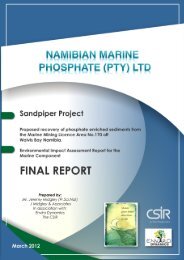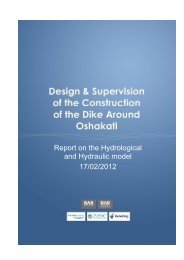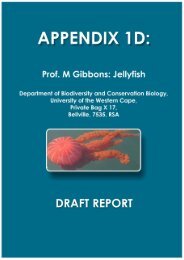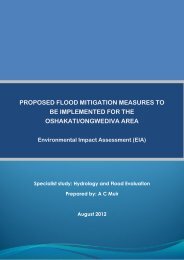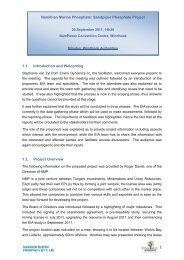Fisheries - Enviro Dynamics Namibia
Fisheries - Enviro Dynamics Namibia
Fisheries - Enviro Dynamics Namibia
Create successful ePaper yourself
Turn your PDF publications into a flip-book with our unique Google optimized e-Paper software.
10 CONCLUSIONS<br />
F I S H E R I E S , M A M M A L S A N D S E A B I R D S S P E C I A L I S T S T U D Y<br />
Overall we emphasize that our assessment of fish resources, fisheries, marine mammals and birds<br />
is based on the best available data. In the case of fisheries, data have been provided by the<br />
Ministry of <strong>Fisheries</strong> and Marine Resources. The analyses undertaken using these data are aimed<br />
only at informing the EIA as best possible regarding the risks of the proposed mining. We wish to<br />
stress also that with respect to the impact on commercial fisheries, our assessment equates more<br />
to a broad operational impact rather than an environmental one.<br />
With respect to the risk assessment of the impact on the broader ecosystem, the assessment is<br />
“data poor” and inadequate to fully assess the likely impacts of dredging on the <strong>Namibia</strong>n marine<br />
environment (including biodiversity and trophic ecology). We stress however that this uncertainty<br />
could apply equally to other exploited marine resources (such as fishing and diamond mining)<br />
where there is much uncertainty regarding ecosystem impacts and the extent to which<br />
anthropogenic activities (historical and current) may already have altered the marine<br />
environment.<br />
Five critical impacts have been identified.<br />
The impact on <strong>Namibia</strong>n fisheries will vary depending on the fishing sector.<br />
The operations of all fisheries will in some way, and at different levels of intensity, be impacted.<br />
Overall however the significance is considered to be negative and medium to low primarily<br />
because the area to be mined (annually up to 3 km 2 and for the 20 year mining lifespan up to 60<br />
km 2 ) is a small fraction of the overall <strong>Namibia</strong>n fishing grounds. This fraction may however<br />
increase significantly if mining of this nature is to be expanded or alternative mine sites<br />
introduced.<br />
Of the main commercial fisheries, the monk-directed trawl fishery will be most impacted. The<br />
species exploited (monk) prefers muddy/sandy substrate of which the dredging operation as<br />
proposed, will remove 60 km 2 for the duration of the mining licence. The monk-directed catch<br />
and effort data and trawling locations from 2005-2010 suggest that about 1% of the total monk<br />
fishing grounds in SP-2 will be lost, 0.08% in SP-3 and zero % in SP-1 i.e a direct impact in the actual<br />
mined site. Further, 19.75 % of the monk fishing grounds in the MLA + Zone 1, may be indirectly<br />
impacted. The actual nature and intensity of the impact away from the actual mined sites cannot<br />
be definitively stated and is also likely to vary and be reduced in intensity further away from the<br />
mining operation. The primary effects of the dredging operation is expected to be disturbance<br />
and removal of the preferred monk substrate resulting in either displacement of monk to<br />
adjacent ground or actual mortality of monk that may be caught in the dredging process.<br />
Similarly the hake trawl and longline fisheries will also lose fishing grounds although this is<br />
unlikely to happen in the first phase of mining as the data provided suggest effort in these<br />
fisheries has not been directed in the SP-1 mining target area. Expansion of the dredging into the<br />
other areas (SP-2 and SP-3) will however increase the exposure of these fisheries to the dredging<br />
operations.<br />
Final Report<br />
<strong>Namibia</strong>n Marine Phosphate (Pty) Ltd.<br />
Page 79



